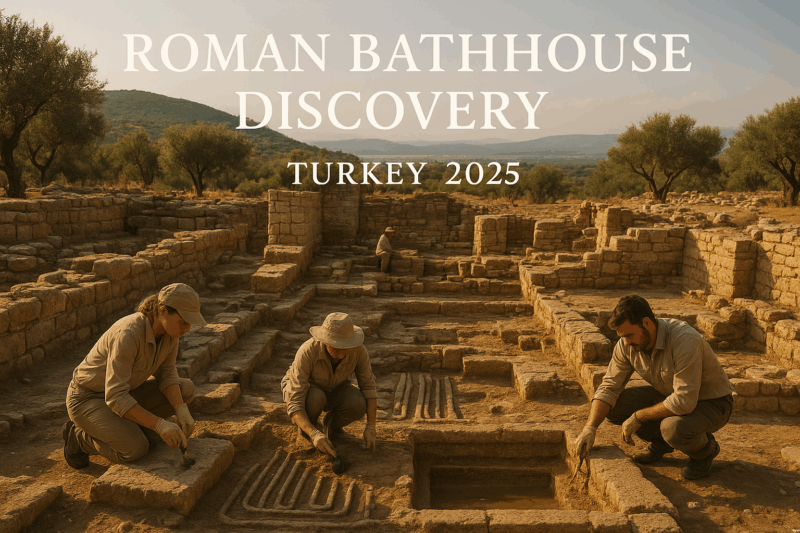A Serendipitous Discovery: When Cherry Trees Lead to Ancient Treasures
In a remarkable twist of fate, what began as a simple agricultural project in Turkey has unveiled one of the most spectacular archaeological finds of recent years. A local landowner planting sour cherry saplings in 2023 accidentally stumbled upon an intricate Roman-era floor mosaic, setting off a chain of discoveries that would reveal a luxurious 1,700-year-old Roman bathhouse complex—an ancient spa that rivals modern wellness facilities in its sophisticated design and engineering.
This extraordinary find offers a window into the sophisticated lifestyle and advanced engineering capabilities of the Late Roman period, demonstrating how chance discoveries can illuminate our understanding of ancient civilizations.
The Human Story: Ancient Luxury Meets Modern Wonder
Imagine the excitement of archaeologist Emre Çayır and his team as they uncovered layer after layer of perfectly preserved ancient architecture. Each stone revealed told a story of Roman citizens who once enjoyed the ultimate luxury experience—moving through carefully designed cold, warm, and hot zones in what was essentially the world’s first comprehensive spa complex.
The discovery has captivated local communities and international archaeology enthusiasts alike. Ahmet Demirdağ, provincial director of culture and tourism, expressed his amazement at finding such a “distinctive and important structure” that has survived nearly two millennia with its engineering intact.
For the local landowner who made the initial discovery, what started as routine agricultural work transformed into a contribution to humanity’s historical knowledge. This chance encounter highlights how ordinary people can play extraordinary roles in uncovering our shared past.
The planned opening of the site for tourism promises to bring economic benefits to the local community while allowing visitors from around the world to experience this marvel of ancient engineering firsthand.
Architectural Marvel: Engineering and Design Details
The newly discovered Roman bathhouse spans an impressive 75 square meters and represents a masterpiece of ancient engineering and urban planning. The structure’s sophisticated features reveal the advanced technological capabilities of Roman architects and engineers from 1,700 years ago.
Key architectural features include:
- Advanced underfloor heating system (hypocaust) that distributed warm air throughout the complex
- Distinct temperature zones: cold (frigidarium), warm (tepidarium), and hot (caldarium) areas
- Dedicated sweat rooms designed for therapeutic and cleansing purposes
- Multiple pools of varying temperatures for different bathing experiences
- Separate water management systems with distinct channels for clean water supply and wastewater removal
- Intact structural engineering that has survived Turkish winters and seismic activity for nearly two millennia
Discovery methodology:
- Initial find: Roman-era floor mosaic discovered during cherry tree planting in 2023
- Location: Bathhouse found 230 feet south of the original mosaic using underground imaging radar
- Size: 75 square meters of preserved Late Roman period architecture
- Dating: Approximately 1,700 years old, from the Late Roman era
The preservation quality has amazed archaeologists, with Emre Çayır noting that “the cold, warm, and hot sections have survived with their full, planned engineering intact.”
Historical Context: Roman Bathing Culture and Urban Development
This bathhouse discovery provides crucial insights into Roman bathing culture and urban development patterns during the Late Roman period. Roman bathhouses weren’t merely places for washing—they served as sophisticated social centers where citizens conducted business, exercised, and maintained social relationships.
The Roman Spa Experience
Roman bathhouses followed a traditional sequence that this Turkish discovery perfectly exemplifies:
- Apodyterium (changing room) – where bathers stored clothing and belongings
- Palaestra (exercise area) – for physical activity before bathing
- Frigidarium (cold room) – featuring cold pools for invigorating plunges
- Tepidarium (warm room) – a transitional space with moderate temperatures
- Caldarium (hot room) – the hottest area with steam and hot pools
- Sudatorium (sweat room) – specialized spaces for therapeutic sweating
Engineering Innovation
The sophisticated water and heating systems discovered in Turkey demonstrate Roman engineering excellence:
- Hypocaust heating: Hot air circulated beneath raised floors and through wall cavities
- Hydraulic engineering: Separate channels managed fresh water supply and waste removal
- Temperature control: Multiple zones allowed for graduated thermal experiences
- Structural durability: Construction techniques that have preserved the facility for 1,700 years
Archaeological Significance and Future Implications
This discovery contributes significantly to our understanding of Roman provincial life and urban development patterns. The fact that such an elaborate bathhouse existed in this Turkish location suggests the area was once a substantial urban settlement with considerable wealth and importance.
Broader Archaeological Context
Turkey continues to yield remarkable archaeological discoveries, with recent finds including:
- A fifth-century Christian church with mysterious inscriptions
- Ancient Bronze Age bread preserved for 5,000 years
- Various Roman military settlements and artifacts
The bathhouse discovery fits into this pattern of significant finds that are reshaping our understanding of ancient Anatolia’s role in Roman civilization.
Tourism and Economic Development
Turkish officials plan to open the site for tourism, which could provide several benefits:
- Economic development for the local community
- Educational opportunities for visitors to experience Roman engineering
- Preservation funding through tourism revenue
- International recognition for Turkey’s archaeological heritage
Looking Forward: Continued Excavations and Discoveries
Archaeologists plan to continue excavations in the area, believing this bathhouse represents just one component of a larger urban settlement. Ahmet Demirdağ’s observation that “we believe this area was an urban settlement” suggests future discoveries may reveal additional structures, residential areas, and potentially commercial districts.
The use of advanced underground imaging radar demonstrates how modern technology can enhance archaeological discovery, potentially revealing additional structures without invasive digging. This approach may uncover more of the ancient city’s layout while preserving delicate archaeological remains.
Implications for Roman Studies
This discovery adds to our understanding of:
- Roman provincial architecture and urban planning
- Late Roman period engineering capabilities
- Social and cultural practices in Roman Anatolia
- Economic prosperity and lifestyle in ancient Turkish settlements
Conclusion: Where Ancient Luxury Meets Modern Discovery
The 1,700-year-old Roman bathhouse unearthed in Turkey represents more than just an archaeological find—it’s a bridge connecting ancient Roman luxury with modern discovery. This sophisticated spa complex, with its advanced heating systems, multiple temperature zones, and elegant design, demonstrates that the pursuit of wellness and luxury has remained constant throughout human history.
From a chance discovery during cherry tree planting to a planned tourist destination, this ancient Roman bathhouse exemplifies how the past continues to enrich our present. As archaeologists continue their excavations, each stone uncovered adds another piece to the complex puzzle of Roman civilization’s influence on modern-day Turkey.
The preservation of this bathhouse’s “full, planned engineering” after 1,700 years stands as a testament to Roman architectural excellence and provides future generations with an authentic glimpse into the sophisticated lifestyle enjoyed by ancient civilizations. When the site opens for tourism, visitors will have the rare opportunity to walk through the same spaces where Romans once enjoyed the ultimate luxury spa experience, connecting directly with our shared human heritage.




